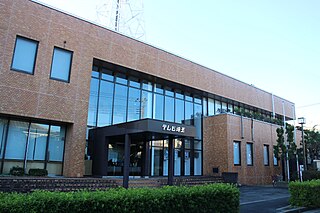
The mass media in Japan include numerous television and radio networks as well as newspapers and magazines in Japan. For the most part, television networks were established based on capital investments by existing radio networks. Variety shows, serial dramas, and news constitute a large percentage of Japanese evening shows.
Japan FM Network is a Japanese commercial radio network. It was founded in 1981.

Kyoto Broadcasting System Company, Ltd is a commercial broadcasting station headquartered in Kyoto, Japan. It is doing business in Kyoto Prefecture as KBS Kyoto (KBS京都) and in Shiga Prefecture as "KBS Shiga" (KBS滋賀)

Sun Television Co., Ltd. is a commercial television station headquartered in Kobe, Hyōgo Prefecture, Japan, and a member of the Japanese Association of Independent Television Stations (JAITS).

Chubu-Nippon Broadcasting Co., Ltd. is a regional radio and television service serving Nagoya, Aichi Prefecture, Japan. It is majorly owned by the Chunichi Shimbun. Its radio service is affiliated with the Japan Radio Network (JRN) and its television service affiliated with the Japan News Network (JNN).

Biwako Broadcasting Co., Ltd. (BBC), is a fee-free commercial terrestrial television station serving Shiga Prefecture of Japan. It was started broadcasting in 1972.

JOMX-DTV, branded as Tokyo MX, is an independent television station in Tokyo, Japan, owned by the Tokyo Metropolitan Television Broadcasting Corporation. It is the only television station that exclusively serves the city and parts of nearby prefectures. It competes with Nippon Television, TV Asahi, NHK General TV, NHK Educational TV, TBS TV, TV Tokyo, and Fuji TV, all of which are flagship stations of national networks. Tokyo MX was founded on April 30, 1993, and broadcasts commenced on November 1, 1995. Shareholders include the Tokyo Metropolitan Government, Tokyo FM Broadcasting, and others.

JORY-DTV, also known as QAB is a Japanese television station serving Okinawa Prefecture as an affiliate of the All-Nippon News Network. The station is owned-and-operated by Ryukyu Asahi Broadcasting Corporation and its studios and headquarters are located in the Kumoji district of Naha, which is shared with the headquarters for Ryukyu Broadcasting Corporation, which QAB has a relationship with.
UHF anime refers to the anime broadcast by independent stations generally located in the Kanto, Chukyo and Kansai regions of Japan, who are members of the Japanese Association of Independent Television Stations (JAITS). Other common names for UHF anime include U-kyoku anime (U局アニメ) and U-kei anime (U系アニメ). The UHF anime are usually produced by "production committees", formed by the packaged media, merchandising and video game stakeholders, with limited commitment from the broadcasters for broadcast self-regulation. In contrast to the major network stations such as TV Tokyo who are the leading stakeholders in the production, the producers often pay the broadcasters as brokered programming.

Chiba Television Broadcasting Corporation (CTC), doing business as Chiba TV (チバテレビ), is a Japanese commercial terrestrial television broadcasting company headquartered at 11-25 Miyako-chō 1-chōme, Chūō-ku, Chiba serving Chiba Prefecture but spill-over is received in the neighbouring prefectures. It is a member of the Japanese Association of Independent Television Stations (JAITS). It is often involved in UHF anime "production committee" projects chairing other stations. Most anime broadcasts are what are considered seinen anime.

Television Saitama Co., Ltd. abbreviated TVS, doing business as Teletama is a Japanese fee-free terrestrial commercial television broadcasting company headquartered in Urawa-ku, Saitama City, Saitama Prefecture, Japan. Its intended coverage is Saitama Prefecture but with some spill-overs in surrounding prefectures. Teletama is an "independent" terrestrial television station, which means not belonging to any major national networks keyed in Tokyo and Osaka. It is a member of the Japanese Association of Independent Television Stations (JAITS) and co-produces, exchanges programs and sells advertising opportunity with other members.

NHK General TV, abbreviated on-screen as NHK G, is the main television service of NHK, the Japanese public broadcaster. Its programming includes news, drama, quiz/variety shows, music, sports, anime, and specials which compete directly with the output of its commercial counterparts. The channel is well known for its nightly newscasts, regular documentary specials, and popular historical dramas. Among the programs NHK General TV broadcasts are the annual New Year's Eve spectacular Kōhaku Uta Gassen, the year-long Taiga drama, and the daytime Asadora.

NHK Educational TV, abbreviated on-screen as NHK E, is the second television service of NHK. It is a sister service of NHK General TV, showing programs of a more educational, documentaries, cultural, children's or intellectual nature, periodically also showing anime, and also airing programming from Nickelodeon. A similar counterpart would be PBS of the United States. NHK displays a watermark "NHK E" at the upper right for its digital TV broadcast. In 2010, NHK began using the abbreviation E Tele.

The Open University of Japan is a distance learning university which has students from all over Japan; it accepted its first students in 1985.
This article lists and describes the features of mass media based in Saitama Prefecture of Japan. Most are based in the capital and most populous city Saitama City's Urawa ward. Unless mentioned otherwise the language is Japanese.
Television in Japan was introduced in 1939. However, experiments date back to the 1920s, with Kenjiro Takayanagi's pioneering experiments in electronic television. Television broadcasting was halted by World War II, after which regular television broadcasting began in 1950. After Japan developed the first HDTV systems in the 1960s, MUSE/Hi-Vision was introduced in the 1970s.

UHF television broadcasting is the use of ultra high frequency (UHF) radio for over-the-air transmission of television signals. UHF frequencies are used for both analog and digital television broadcasts. UHF channels are typically given higher channel numbers, like the US arrangement with VHF channels (initially) 1 to 13, and UHF channels (initially) numbered 14 to 83. Compared with an equivalent VHF television transmitter, to cover the same geographic area with a UHF transmitter requires a higher effective radiated power, implying a more powerful transmitter or a more complex antenna. However, the additional channels allow more broadcasters in a given region without causing objectionable mutual interference.

Gunma Television, also known as GTV, is a television network headquartered in Gunma Prefecture, Japan. It is a member of the Japanese Association of Independent Television Stations (JAITS). The government of Gunma Prefecture is the biggest shareholder of GTV, and they broadcast its promotion program on GTV.

JOOY-DTV, branded as MBS TV, is the Kansai region key station of the Japan News Network, owned by Mainichi Broadcasting System, Inc., a subsidiary of MBS Media Holdings.

Wakayama Telecasting Corp., also known as WTV, is a Japanese commercial terrestrial television station, founded in 1973 and headquartered in Wakayama, Japan. It is a member of the Japanese Association of Independent Television Stations (JAITS). It is the only commercial television station whose headquarter is located in Wakayama Prefecture. The callsign of WTV is JOOM-DTV.
















